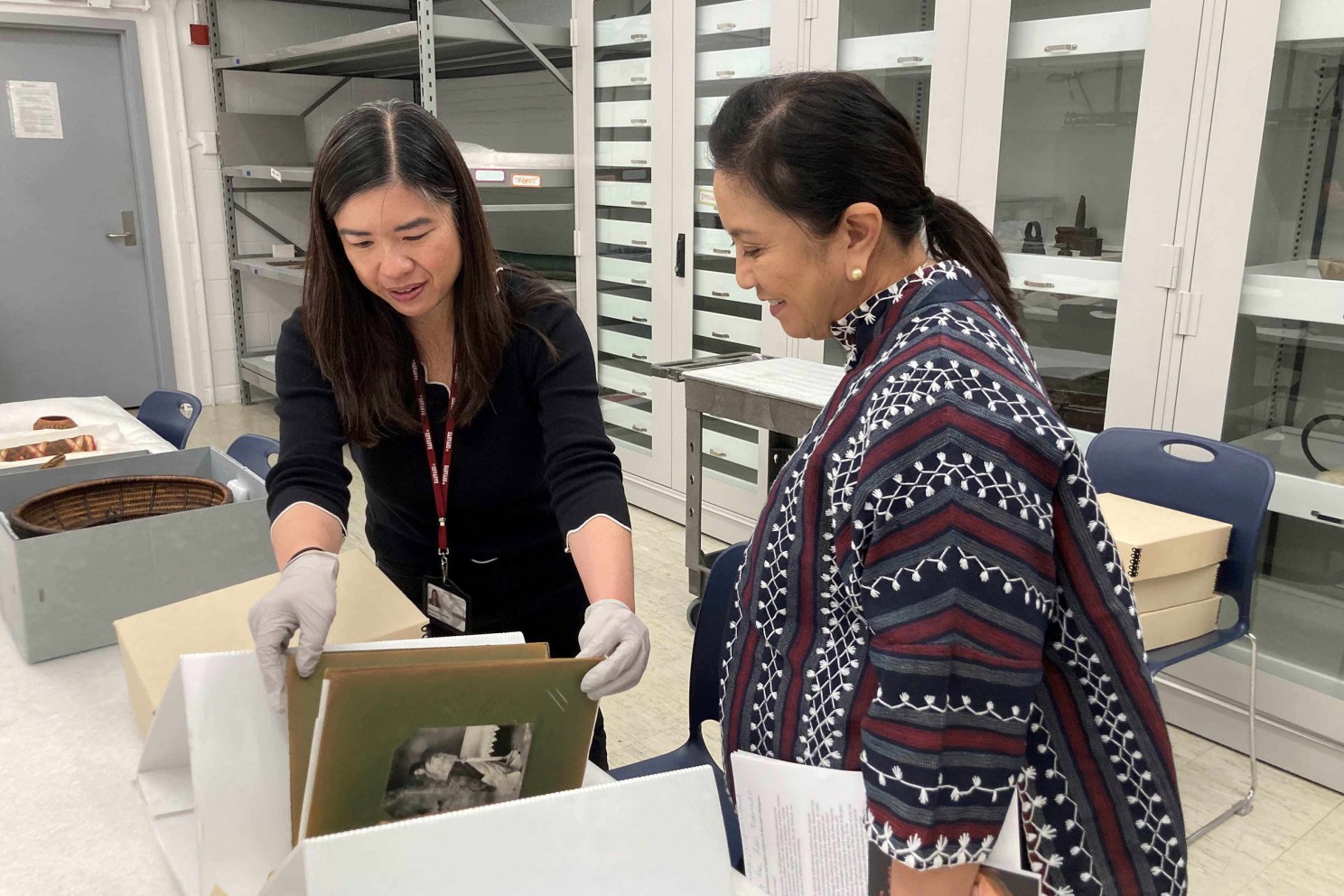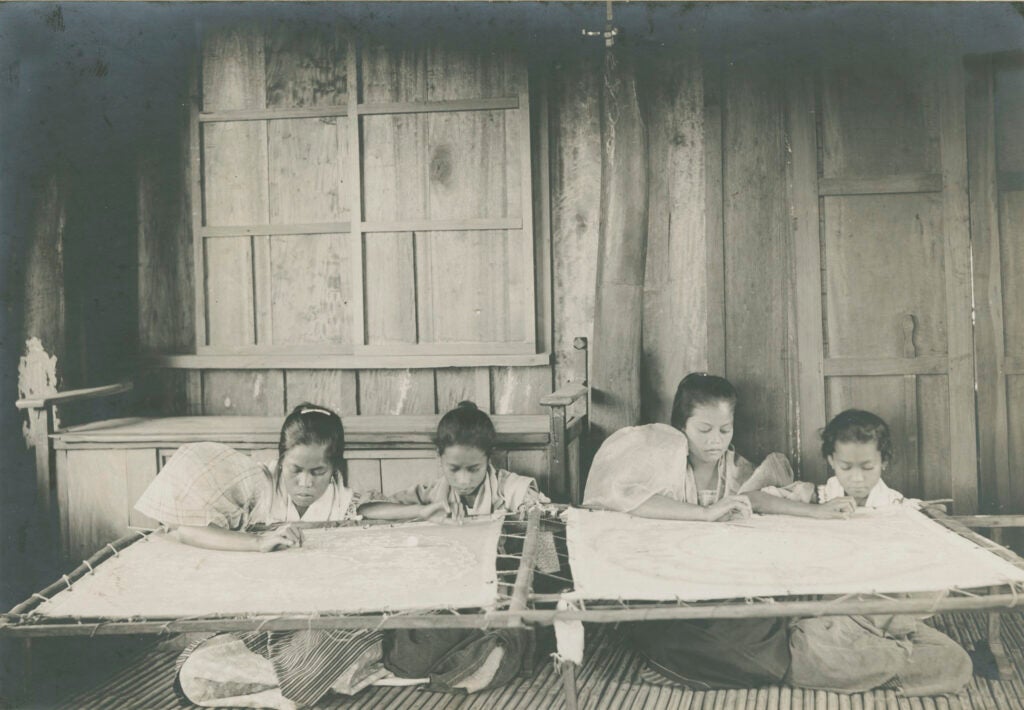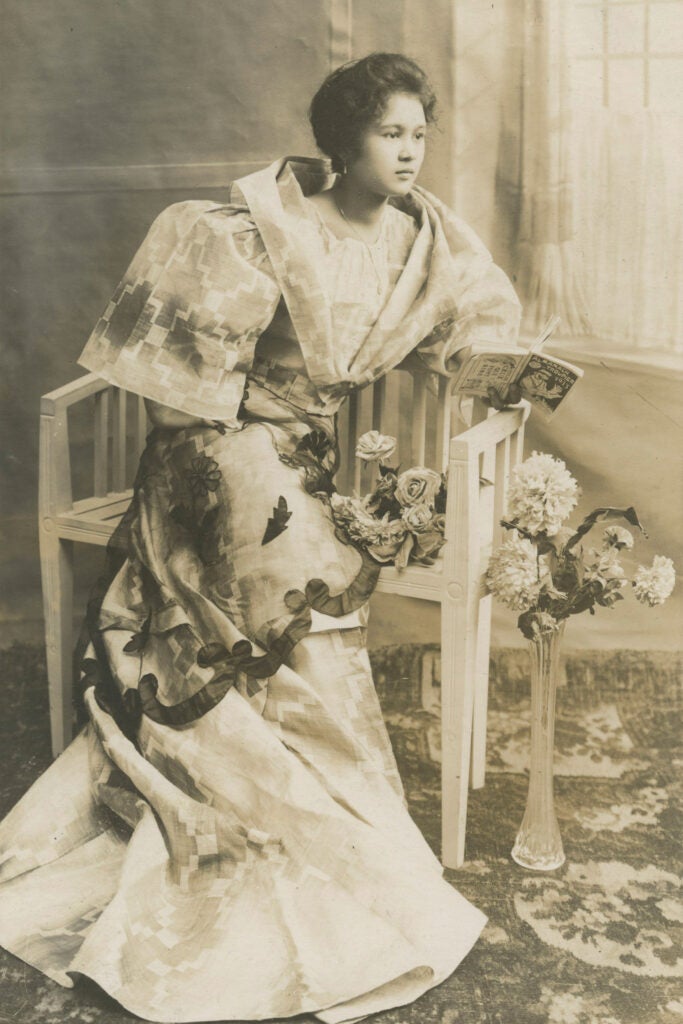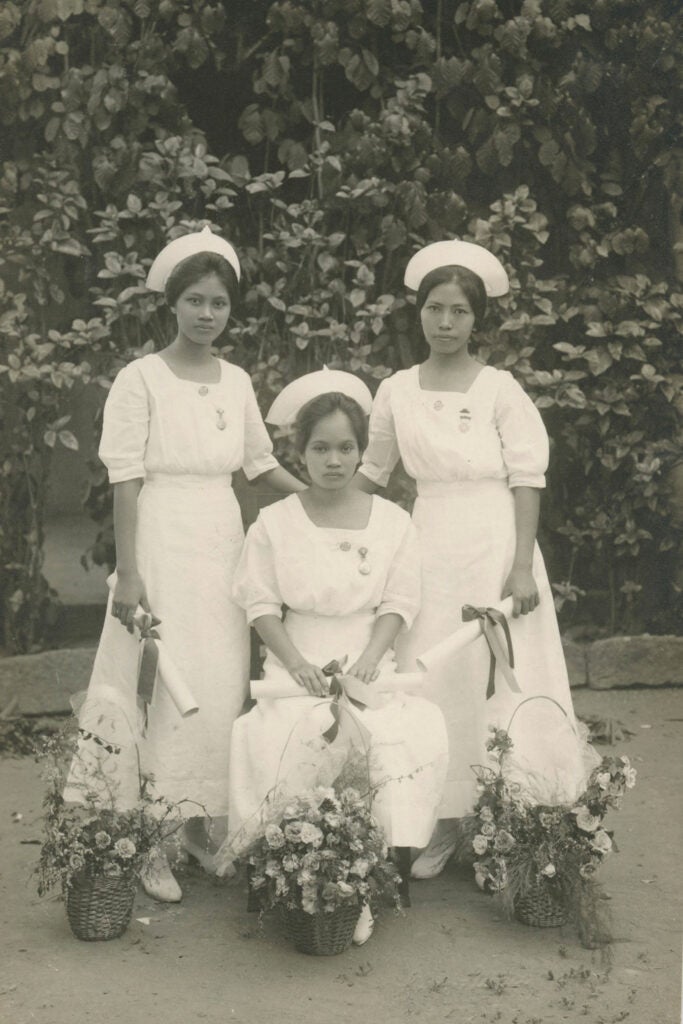Digging into the Philippines Collections at the Peabody Museum

Photo by Jeromel Dela Rosa Lara ’23.
Filipino American archivist offers personal perspective to exhibit
As part of Asian American Pacific Islander Heritage Month and to mark the digital launch of its exhibit “Balikbayan | Homecoming: Filipino Perspectives on the Philippine Collections,” the Peabody Museum of Archaeology & Ethnology spoke with Associate Archivist Marie Wasnock, a Filipino American from Hawaii who worked on the exhibit.
You’re currently helping curator of Oceanic Collections Ingrid Ahlgren with her upcoming online exhibit “Balikbayan | Homecoming: Filipino Perspectives on the Philippine Collections,” launching Wednesday. You’re also one of the participants who is reflecting on the collections. What has that been like?
I’m usually busy helping researchers search for information or access collections, so I rarely get to do research myself. But the online exhibit has given me the perfect opportunity to dig into the collections at the Peabody Museum and at Harvard University libraries, learn more about my cultural heritage, and reflect on my own identity as a Filipino-American.
Looking through the photograph collections about the Philippines can be a powerful experience, evoking many feelings, emotions, and questions. Many of the images are heavy reminders of the American colonization of the Philippines in the late 19th and early 20th centuries, and those can be difficult, disturbing, or offensive to see. However, beyond the colonial lens of these images, there are also photos that show the cultural and geographical diversity of the Philippines. There is very little information accompanying these photographs, so many questions come to mind when I look at these images — about the people, the land, the languages, art, culture, and traditions — encouraging me to explore them further to find answers.
“Growing up in America, you do not usually learn about the Philippines’ complicated colonial history or the complexities of Filipino culture and identity in your standard social studies class.”

Girls embroidering traditional Filipino piña fabric made from the fibers of the pineapple plant.
Gift of William Cameron Forbes, 1912. Courtesy of the Peabody Museum of Archaeology and Ethnology
Tell us more about those images.
More than 5,700 Philippines photos in the Peabody have been scanned and made available in the Peabody Museum’s Collections Online. When these photos were taken between 1899 and 1912, the Philippines was still a new and unfamiliar place to most Americans and perhaps the rest of the world. The photos were created by a team of American photographers and amateur anthropologists who were hired by the U.S. government to document the Philippines in hopes of learning more about their new colonial acquisition after the Spanish-American War. Although the photos come with limited information about the ethnic groups and provinces that were photographed, viewers can see how culturally and biologically diverse the Philippines is just by looking at the breadth of these images.
There are still several photo albums in the collection that are unidentified and not digitized. For example, I found one mysterious photo album containing many unidentified portraits of Filipina women in traditional Filipiniana dress. This album struck my curiosity when I showed it to former Philippine Vice President Leni Robredo during her visit to the museum. Some of the women appear to be students, nurses, musicians, etc., but there is little to no information about them in the Peabody’s archives. I wanted to be able to identify at least one of these women and get a sense of what it was like being female in the Philippines in the early 20th century.
The photo collection was donated by former U.S. governor-general to the Philippines and Harvard alumnus William Cameron Forbes. Many of his journals and personal papers are held at Harvard’s Houghton Library, so I continued my research there. I hoped to learn more about Forbes’ service in the Philippines, the provinces he visited, and the people he encountered. He kept very thorough and detailed journals during his 10 years living there — and even created an index for his 10 volumes of journal — so that was extremely helpful to understanding many of the photos. In the exhibit, I take readers on my archival journey to learn more about these photographs and the women in them.

Women preparing to extract oil for cooking in Nueva Ecija province, circa 1898-1912. Wasnock recalls family stories of her grandmother running the Uytingco Bakery in Gapan, Nueva Ecija, Philippines.
Gift of William Cameron Forbes, 1912. Courtesy of the Peabody Museum of Archaeology and Ethnology

Young lady wearing a traditional baro’t saya or “blouse and skirt,” made of pineapple fabric called piña, an indigenous textile of the Philippines, circa 1909.
Gift of William Cameron Forbes, 1912. Courtesy of the Peabody Museum of Archaeology and Ethnology

Three Filipina nurses who received awards for the highest averages and technique work in the operating room, circa 1909.
Gift of William Cameron Forbes, 1912. Courtesy of the Peabody Museum of Archaeology and Ethnology
How has the collection research connected with you personally?
Growing up in America, you do not usually learn about the Philippines’ complicated colonial history or the complexities of Filipino culture and identity in your standard social studies class. I don’t think many people realize that there are more than 7,000 islands in the Philippines and more than 100 ethnolinguistic groups in its population. As a Filipino American who was born and raised in Hawaii, I’ve often felt like I wasn’t “Filipino enough,” especially because I don’t know the language and haven’t spent a lot of time the Philippines. But I believe one commonality that links many Filipinos are the values our elders instilled in us and the respect we have for family, culture, faith, land, and education. I feel even more connected to my Filipino heritage now that I have a better understanding of the country’s history and have had a chance to reflect on and appreciate my personal experiences and memories of growing up in a Filipino family.
My mom is from Manila, and she was thrilled to learn about this exhibit. She reminds me how lucky I am to have access to these resources at Harvard, and while that is true, really anyone can ask to view these collections at the Peabody Museum and at Houghton Library. I’m honored as a librarian and an archivist to introduce these collections to people who are interested in them. My father was from the city of Gapan in the Nueva Ecija province. I was actually able to find some photos of Gapan and it’s really great to envision the memories that my family has of the Philippines. He passed away almost 10 years ago, so I wish he could see the work I’m doing. He was a proud Filipino and would have been happy to see how we’re highlighting Philippine culture.
What’s a typical day for you in the Peabody Museum’s archives?
I help researchers in the Harvard community as well as the general public find what they’re looking for in the archives, typically photographs and papers such as field notebooks, manuscripts, and other historical documents. I also host researchers and class visits when they want to study archival materials in the museum. Most of my days are spent finding answers to research questions from people all over the world — it can be very fascinating!

Three Kings Parish and Minor Basilica and National Shrine of La Virgen Divina Pastora in Gapan, Nueva Ecija, Philippines, circa 1898-1912.
Gift of William Cameron Forbes, 1912. Courtesy of the Peabody Museum of Archaeology and Ethnology
Do you have any other highlights of your time in the Peabody’s archives?
Last fall, former Philippines Vice President Leni Robredo was a Hauser Leader at the Harvard Kennedy School. Jeromel Dela Rosa Lara ’23 brought her to the museum, and I got to meet and show her some items from the collection, including that mysterious photo album.
I love my job at the Peabody Museum because it often feels like I’m an armchair anthropologist, meeting people from all over the world, learning about their research, and learning about world cultures and history along the way. Being an archivist is also almost like being an archaeologist, but we dig through boxes of papers and photographs for information about the past.
As part of ArtsThursdays, “Celebrate Filipino Heritage” at the Peabody Museum of Archaeology & Ethnology from 5 to 9 p.m. Thursday (May 30).




